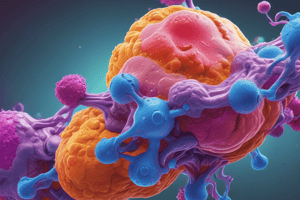Podcast
Questions and Answers
Which design has more number of tests?
Which design has more number of tests?
- Central Composite Design (correct)
- Box-Behnken Design
- Both designs have the same number of tests
- Neither design has a specified number of tests
Which statement is true regarding the star points in designs?
Which statement is true regarding the star points in designs?
- Box-Behnken design has star points
- Central Composite Design has star points (correct)
- Box-Behnken design uses star points for its structure
- Central Composite Design has no star points
How many levels does the Box-Behnken Design utilize?
How many levels does the Box-Behnken Design utilize?
- 5 levels
- 3 levels (correct)
- 2 levels
- 4 levels
Which design type is rotatable?
Which design type is rotatable?
Which design is characterized by extreme points?
Which design is characterized by extreme points?
What is the general form of a second-order model in two-variable response surfaces?
What is the general form of a second-order model in two-variable response surfaces?
In a full factorial design (FFD) with 2 factors, each at 3 levels, how many trials would be conducted if each setup is done in triplicates?
In a full factorial design (FFD) with 2 factors, each at 3 levels, how many trials would be conducted if each setup is done in triplicates?
How many runs are needed in a full factorial design with 3 factors, each at 4 levels, conducted in triplicates?
How many runs are needed in a full factorial design with 3 factors, each at 4 levels, conducted in triplicates?
What is represented by the notation $nK$ in the context of a full factorial design?
What is represented by the notation $nK$ in the context of a full factorial design?
When conducting experiments with 2 factors, each having high (+) and low (-) values, how many unique combinations are generated in a 2-level full factorial design?
When conducting experiments with 2 factors, each having high (+) and low (-) values, how many unique combinations are generated in a 2-level full factorial design?
What is the main purpose of using response surface methodology?
What is the main purpose of using response surface methodology?
In a response surface model, which term specifically addresses the interaction between two variables?
In a response surface model, which term specifically addresses the interaction between two variables?
If an experiment includes two factors each at 3 levels and is replicated once, what is the factor level configuration?
If an experiment includes two factors each at 3 levels and is replicated once, what is the factor level configuration?
What should be the primary consideration when choosing an experimental design?
What should be the primary consideration when choosing an experimental design?
Which of the following designs can be used when dealing with two to four factors?
Which of the following designs can be used when dealing with two to four factors?
What is the objective of a central composite design in experimental design?
What is the objective of a central composite design in experimental design?
Which design is recommended for five or more factors?
Which design is recommended for five or more factors?
What is the purpose of screening in the context of experimental design?
What is the purpose of screening in the context of experimental design?
Which of the following designs is a form of fractional design?
Which of the following designs is a form of fractional design?
When conducting a response surface methodology, which design assists in exploring interactions among independent variables?
When conducting a response surface methodology, which design assists in exploring interactions among independent variables?
In which scenario would a randomized block design be most beneficial?
In which scenario would a randomized block design be most beneficial?
What is the primary purpose of the ANOVA stage in model evaluation?
What is the primary purpose of the ANOVA stage in model evaluation?
During model diagnostics, which is NOT typically validated through examination of diagnostic graphs?
During model diagnostics, which is NOT typically validated through examination of diagnostic graphs?
What is indicated by an R2 value that is near or close to 1?
What is indicated by an R2 value that is near or close to 1?
Which limit is acceptable for the adjusted R2 relative to the predicted R2?
Which limit is acceptable for the adjusted R2 relative to the predicted R2?
What does a lack of fit p-value greater than 0.05 imply about the model?
What does a lack of fit p-value greater than 0.05 imply about the model?
Which is true about generating contour and 3D plots during model graphs?
Which is true about generating contour and 3D plots during model graphs?
What does it indicate when the difference between adjusted R2 and predicted R2 is greater than 0.2?
What does it indicate when the difference between adjusted R2 and predicted R2 is greater than 0.2?
What is the role of confirmation runs in model analysis?
What is the role of confirmation runs in model analysis?
What characterizes the Central Composite Design in response surface methodology?
What characterizes the Central Composite Design in response surface methodology?
Which statement is true regarding the Box-Behnken Design?
Which statement is true regarding the Box-Behnken Design?
What is a key feature of the factors in a Box-Behnken design?
What is a key feature of the factors in a Box-Behnken design?
Which design is described as an independent quadratic design?
Which design is described as an independent quadratic design?
What is the primary requirement for a design to be considered rotatable?
What is the primary requirement for a design to be considered rotatable?
Which of the following statements about Central Composite Design is incorrect?
Which of the following statements about Central Composite Design is incorrect?
In the context of response surface methodology, what distinguishes a design that is near rotatable?
In the context of response surface methodology, what distinguishes a design that is near rotatable?
What does the treatment combination arrangement in Central Composite Design include?
What does the treatment combination arrangement in Central Composite Design include?
What is indicated if points in a predicted vs. actual plot fall along a diagonal line?
What is indicated if points in a predicted vs. actual plot fall along a diagonal line?
In evaluating residuals, what is a red flag indicating the model may not be appropriate?
In evaluating residuals, what is a red flag indicating the model may not be appropriate?
What does a Box-Cox plot help to assess for the response variable?
What does a Box-Cox plot help to assess for the response variable?
Which characteristic is NOT features of a good design of experiment (DOE) using RSM?
Which characteristic is NOT features of a good design of experiment (DOE) using RSM?
What does identifying trends or patterns in the residuals vs Run plot indicate?
What does identifying trends or patterns in the residuals vs Run plot indicate?
Which aspect is crucial for guiding statistical analysis in the context of RSM?
Which aspect is crucial for guiding statistical analysis in the context of RSM?
What can be concluded if the lambda of the Box-Cox transformation is 1?
What can be concluded if the lambda of the Box-Cox transformation is 1?
What is a necessary property for effective distribution of data points in RSM?
What is a necessary property for effective distribution of data points in RSM?
Flashcards
Experimental Design Choice
Experimental Design Choice
The choice of experimental design depends on the goal of the research.
One-Factor Design
One-Factor Design
An experiment designed to study the effects of a single factor.
Two to Four Factor Design
Two to Four Factor Design
Used when there are two to four factors to investigate, allowing for the study of interactions between them.
Fractional Factorial Design
Fractional Factorial Design
Signup and view all the flashcards
Screening Design (Five or More Factors)
Screening Design (Five or More Factors)
Signup and view all the flashcards
Response Surface Methodology (RSM)
Response Surface Methodology (RSM)
Signup and view all the flashcards
Central Composite Design
Central Composite Design
Signup and view all the flashcards
Box-Behnken Design
Box-Behnken Design
Signup and view all the flashcards
Second-Order Model
Second-Order Model
Signup and view all the flashcards
Full Factorial Design (FFD)
Full Factorial Design (FFD)
Signup and view all the flashcards
k
k
Signup and view all the flashcards
n
n
Signup and view all the flashcards
n^k
n^k
Signup and view all the flashcards
2^k factorial
2^k factorial
Signup and view all the flashcards
Replicates
Replicates
Signup and view all the flashcards
n^k x r
n^k x r
Signup and view all the flashcards
Central Composite Design (CCD)
Central Composite Design (CCD)
Signup and view all the flashcards
Box-Behnken Design (BBD)
Box-Behnken Design (BBD)
Signup and view all the flashcards
Levels
Levels
Signup and view all the flashcards
Number of Tests
Number of Tests
Signup and view all the flashcards
Rotatable Designs
Rotatable Designs
Signup and view all the flashcards
R-squared
R-squared
Signup and view all the flashcards
Adjusted R-squared
Adjusted R-squared
Signup and view all the flashcards
Predicted R-squared
Predicted R-squared
Signup and view all the flashcards
Lack of Fit Test
Lack of Fit Test
Signup and view all the flashcards
Model Test
Model Test
Signup and view all the flashcards
Diagnostic Graphs
Diagnostic Graphs
Signup and view all the flashcards
Model Graphs
Model Graphs
Signup and view all the flashcards
Confirmation Runs
Confirmation Runs
Signup and view all the flashcards
Predicted vs. Residuals
Predicted vs. Residuals
Signup and view all the flashcards
Residuals vs. Run
Residuals vs. Run
Signup and view all the flashcards
Predicted vs. Actual
Predicted vs. Actual
Signup and view all the flashcards
Box-Cox Plot
Box-Cox Plot
Signup and view all the flashcards
Response Surface Methodology
Response Surface Methodology
Signup and view all the flashcards
Features of a Good DOE using RSM
Features of a Good DOE using RSM
Signup and view all the flashcards
Distribution of Data Points
Distribution of Data Points
Signup and view all the flashcards
Testing Model Adequacy
Testing Model Adequacy
Signup and view all the flashcards
Study Notes
Choosing Your Experimental Design
- The design depends on the experiment's objective
- One factor: completely randomized design
- Two to four factors: randomized block design
- Five or more factors: randomized block design, full or fractional factorial, or screening (reducing factors)
Response Surface Methodology (RSM)
- A collection of mathematical and statistical methods for modeling
- Analyzes processes where the response of interest is affected by various variables
- Aims to optimize processes
Considerations in RSM
- Requires a quantitative response affected by continuous factors
- Works best with a limited number of critical factors (screening)
- Produces an empirical polynomial model approximating the true response
- Seeks optimal factor settings (maximizing, minimizing, or stabilizing the response)
RSM Workflow
- Screening: Identify known and unknown factors. Characterize factor effects and interactions. Determine if curvature is present
- Characterization: Analyze factor effects and interactions.
- Optimization: If curvature is present, apply RSM. Confirm the optimization.
- Verification: Confirm the results obtained
RSM Workflow: Screening
- Analyze known and unknown factors
- Characterize factor effects and interactions
- Determine if curvature is present
- Confirmation if no curvature is observed
RSM Workflow: Characterization
- Analyze factor effects and interactions
- Evaluate whether RSM is required for optimization
RSM Workflow: Optimization
- Apply RSM if curvature is observed during characterization
- Confirm the results obtained
Full Factorial Design (FFD)
- An experimental design with two or more factors and multiple discrete values/levels
- Example: 2k factorial (2 levels), 3k factorial (3 levels)
- Can be used for more than 2 factors
- Example factorial design is shown with replicates for 3 levels of each of 2 factors
- Factorial points based on levels in the experiment
FFD vs RSM Designs (CCD and BBD)
- Central Composite Design (CCD): Embeds a factorial design, augmented with center and 'star' points to estimate curvature
- Box-Behnken Design (BBD): An independent quadratic design, with treatment combinations at edge midpoints and center points, and 3 levels for each factor.
RSM Designs: CCD vs BBD
- Central Composite Design (CCD) has extreme points and center points
- Box-Behnken Design (BBD) has midpoint points for combination of levels
Sample Problems using Design Expert
- Example problem using CCD to optimize the extraction process for metabolites
- Includes data on time, temperature, and yield.
Analysis Procedure
- Configure and transform data
- Perform fit summary
- Analyze model
- Examine ANOVA, diagnostics, and model graphs
- Confirm results
Fit Summary Guidelines
- Correlation coefficient R²: close to 1
- Adjusted R²: close to 1
- Predicted R²: greater than p-value (p = 0.05)
- Lack of fit: R²adj - R²p < 0.2
- Model: less than p-value (p = 0.05)
Lack of Fit Test
- Comparisons between actual data and predicted value; variation compared with replicates
Diagnostics
- Evaluate plots to understand model
- Identify if residuals follow a normal distribution (normal plot)
- Check if residuals are randomly scattered about zero (residuals vs. predicted, residuals vs. run)
- Examine relationship between predicted vs. actual values
- Use boxcox plot to understand potential transformations
Features of a Good DOE using RSM
- Provides a reasonable distribution of data throughout the region of interest.
- Allows testing model adequacy.
- Allows experiments to be performed in blocks.
- Designs of higher order to be built sequentially.
- Provides an internal estimate of the error.
- Does not require a large number of runs.
Studying That Suits You
Use AI to generate personalized quizzes and flashcards to suit your learning preferences.




